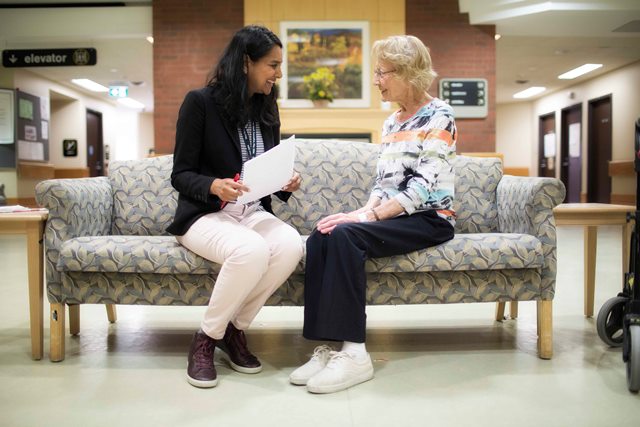By Mariela Castro
Seniors today are more active and living longer.
Senior patients represent a sizeable patient population at West Park Healthcare Centre -– approximately 60 per cent of its rehabilitation patients, and about 80 per cent of its complex continuing care patients, are over the age of 65.
Demand for West Park’s services is expected to grow by 50 per cent over the next two decades. As such, in 2014, West Park established a Geriatric Service Review that engaged seniors, staff, health care providers and partners on how to better service seniors in the future.
Fueled by a need to deliver specialized rehabilitative and complex care to an aging, more active population, and to service community members living longer but with chronic disease and conditions, the Centre set out to address this particular challenge.
Gaining the patient perspective through age related training
Its strategic priorities, patient profile, and the changing demographics of an aging population informed the solution –- to build an integrated campus of care that truly models the way of the future for patient care delivery, education and research.
The innovative healthcare “hub” will offer a continuum of service for those, such as seniors and people with disabilities, who face challenges to their independence. It will extend the continuum of care into the community to support health and the self-management of chronic diseases and other medical conditions.
Building an integrated campus of care to meet the needs of seniors
Shelley Ditty, VP of West Park’s Campus Development, explains, “Our goal is to incorporate the best practices for senior-friendly design, which promote safety, independence and functional well-being throughout all areas of the campus.
As part of West Park’s commitment to help patients reclaim their lives now, and for decades to come, the new West Park campus will consist of two major capital projects –- a New Hospital and a Non-Hospital development. It will bring together specialized rehabilitative, complex continuing, ambulatory and long-term care, along with independent living opportunities and community-based services, on one integrated site.
New services and features benefitting seniors
The contemporary approximately 730,000 square foot New Hospital will accommodate major growth and greater visibility of outpatient services, satellite hemodialysis, and a Geriatric Day Hospital for diagnostic, rehabilitative and therapeutic services to seniors living in the community.
Building on this, senior-friendly design features throughout will include spacious, flexible patient rooms with thoughtful, well-planned elements such as wider doorways and turning radius for large wheelchairs, more power-door operators with hands-free operation, and patient lifts in all rooms. And 13 purposeful outdoor therapy “destinations”, terraces on every floor, and easy access to the outdoors from anywhere in the building. This will enhance therapy options and proximity to the healing effects of nature for all patients, regardless of age or mobility.
The Non-Hospital Development will be a vibrant, active and healthy, mix-use space with close access to medical services, nature, recreation and social engagement for seniors and persons with disabilities. Non-Hospital services will strengthen and complement existing West Park programs, and may include supportive housing, a hospice, community-based services, and primary care all located on an inviting, nurturing site. It will enable an aging population to remain healthy, active and connected to their community while promoting their physical, emotional and social well-being.
Inclusive design, advanced accessibility
“The new campus promises to be fully accessible and adaptable, with flexible space and opportunities for everyone,” says Lorie Pella, Director of Campus Development.
“Developed with accessibility specialists and a West Park accessibility working group, the entire campus was reviewed with a senior-friendly hospital lens. This meant incorporating building code changes under the Accessibility for Ontarians with Disabilities Act (AODA), Code+Plus evidence-based design, staff and patient input on room mock-ups, learnings from comprehensive site visits, and requirements for physical design, furnishings, fixtures and equipment,” he said.
Integrated and embodied into the plans were also the seven principles of Universal Design supporting accessibility – that design be equitable, flexible and simple and intuitive to use; perceptible information; tolerance for error; low physical effort; and size and space for approach and use.
Canada’s healthcare system fails to account for senior migration
The physical, cognitive, social and emotional capabilities, limitations, needs and wants of all people who occupy, work within or visit West Park have been considered. The new site will offer upgraded therapy areas on every floor; assistive listening equipment to amplify sound directly to hearing aids in areas such as the auditorium and reception desks; frequent rest areas along public paths of travel; simple wayfinding with accessible signage and digital options; and integrated bedside terminals, among other advancements.
The long-anticipated West Park integrated campus of care will be a realization of years of careful thought and planning. With it, West Park looks forward to helping more seniors and other patients get back to community, back to family, and back to life.
Mariela Castro works in Communications, Campus Development at West Park Healthcare Centre.


